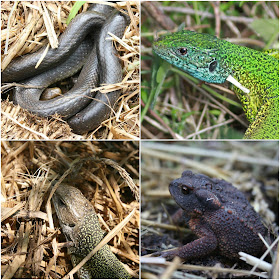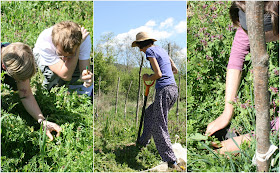The full team is now here and what a great group of people to work with! We're looking forward to productive seasons.
 |
| The Brilliant 2016 Polyculture Market Garden Study Team - (left to right) Marika - Ute - Alex - Charlotte - Kata |
Biodiversity Study
 |
| Photos from our first biodiversity survey - Photos by Ute Villavicencio and Peter Alfrey |
 |
| Bio-blitzing one of our new plots that we'll be planting out as part of the upcoming Perennial Polyculture study. |
Garden Bed Preparation
We've been busy getting the beds prepared for over 2,500 plants going in over the next few weeks. Some will be transplanted from seedling trays and cloches others will be sown directly.
Here's a breakdown of what bed preparation entails.
 |
| Beds with perimeter vegetation mown and weeds chopped and dropped |
Adding Ash - 100-120 g of ash (that's approx a hand trowel full) is sprinkled evenly over each meter length of bed. The ash helps to moderate pH and provides a range of essential plant nutrients. For more on using ash in the garden see here.
Adding Compost - 20 L of compost per m length is applied evenly to surface of the beds.
 |
| We're using composted farmyard manure in the garden. |
Mulching - Straw is applied to the surface of the beds at a rate of 1 bale every 1.5 m of bed length. It's best to wait until the soil has warmed and rain has saturated the soil before applying the mulch.
We collect spoiled straw from local farmers. The bales being wet are of no use to the farmers for animal bedding and we collect them free of charge. Wet bales can sometimes harbour slugs, in which case it's not a great idea to use them for mulch in the vegetable garden. Setting chickens onto infested bales will soon clear the slugs.
Straw bale stacks at least 2 bales high provide excellent habitat for a range of organisms and we leave a bale stack around often finding Aesculapian snake - Zamenis longissimus and Slow Worms - Anguis fragilis sheltering in the bales. Toads - Bufo bufo also use the bales for overwintering and summer shelter as do Balkan Lizard - Lacerta spp.
 |
| Common inhabitants of the straw bale stacks. |
Soil Health Tests
As well as the lab analysis of our soils at the beginning of each season we also take visual tests using a soil health test developed by farmers for farmers to track the development of soil health. More on soil testing and the results from the tests here.
 |
| 8 tests looking at water infiltration, ground cover, soil organisms, soil structure and more are tested using simple equipment. |
Work in the Forest Garden
We spent sometime in the forest garden tending to the newly planted fruit trees, weeding and adding a fresh layer of mulch. We also planted some support plants around the base of the young trees. Listed below are the species planted and their functions.
Caragana arborescens - Nitrogen fixing shrub that will be cut annually to provide biomass both from the roots and shoots of the plant.
Allium tuberosum or Allium cepa proliferum - Perennial vegetables for the market garden that also attract beneficial pest predators and pollinators.
Narcissus poeticus - Early pollenizers attracting bees and other pollinating insects to the garden and providing a nutrient capture when little else is growing during the cold months.
Corydalis spp. - Early pollenizers attracting bees and other pollinating insects to the garden and providing a nutrient capture when little else is growing during the cold months.
Galanthus spp. - Early pollenizers attracting bees and other pollinating insects to the garden and providing a nutrient capture when little else is growing during the cold months.
We'll eventually place boulders around the edges of the tree pits which provide excellent habitat for a range of beneficial organisms. See here for more on rock borders.
We'll eventually place boulders around the edges of the tree pits which provide excellent habitat for a range of beneficial organisms. See here for more on rock borders.
Other work in the forest garden included mowing some access paths, the trimmings of which are fed to the comfrey patch, and cutting back vegetation from the edible hedgerow that overhangs the pathways.
 |
| Pathways are cut into the vegetation using a 50 cm wide lawnmower. This directs foot traffic through the garden and reduces the likelihood of treading on snakes that are active this time of year |
Sending Produce to Market
Produce available this time of year includes fresh garlic, perennial onions, herbs, perennial salad greens and potted herbs & perennial vegetables from our bio-nursery. We're growing a wider variety of crops this year, such as parsnips, beetroot, aubergine and carrots, and are trying out several tasty and unusual varieties of old favourites, such as kale, chard, courgettes, tomatoes and beans.
You can try some of these delicious goodies and directly support the Polyculture Market Garden Study by signing up for our Vegetable Box Scheme (BG language here, ENG language here). We offer three different sized boxes for singles, couples or families and include seasonal fruits in the boxes if desired.
 |
| Contents of our late Summer Vegetable Box |
See here for the results of our polyculture studies from 2014 - 2016
Regenerative Landscape Design - Online Interactive Course
Want to learn how to design, build and manage regenerative landscapes? Join us for our Regenerative Landscape Design - Online Interactive Course from May 1st to Sep 13th, 2023.
We're super excited about running the course and look forward to providing you with the confidence, inspiration, and opportunity to design, build and manage regenerative landscapes, gardens, and farms that produce food and other resources for humans while enhancing biodiversity.

Regenerative Landscape Design Online Course
You can find out all about the course here and right now we have a 20% discount on the full enrollment fees. Just use the promo code RLD2023 in the section of the registration form to receive your discount.
We are looking forward to providing you with this unique online learning experience - as far as we know, the very first of its kind. If you are thinking of reasons why you should do this course and whether this course is suitable for you, take a look here where we lay it all out. Looking forward to it!
We're super excited about running the course and look forward to providing you with the confidence, inspiration, and opportunity to design, build and manage regenerative landscapes, gardens, and farms that produce food and other resources for humans while enhancing biodiversity.
 |
| Regenerative Landscape Design Online Course |
You can find out all about the course here and right now we have a 20% discount on the full enrollment fees. Just use the promo code RLD2023 in the section of the registration form to receive your discount.
We are looking forward to providing you with this unique online learning experience - as far as we know, the very first of its kind. If you are thinking of reasons why you should do this course and whether this course is suitable for you, take a look here where we lay it all out. Looking forward to it!
--------------------------------------------------------------------------------------------------------------------------
 |
| You can also register for our online training, services, and products directly here. |
--------------------------------------------------------------------------------------------------------------------------
--------------------------------------------------------------------------------------------------------------------------
Support Our Project
If you appreciate the work we are doing you can show your support in several ways.
- Make a purchase of plants or seeds from our Bionursery or Online Store
- Consider joining us for one of our Courses or Online Courses
- Donate directly to our project via PayPal to balkanecologyproject@gmail.com or via Cash App to £Sytoma
- Comment, like, and share our content on social media.
If you appreciate the work we are doing you can show your support in several ways.
- Make a purchase of plants or seeds from our Bionursery or Online Store
- Consider joining us for one of our Courses or Online Courses
- Donate directly to our project via PayPal to balkanecologyproject@gmail.com or via Cash App to £Sytoma
- Comment, like, and share our content on social media.






No comments:
Post a Comment